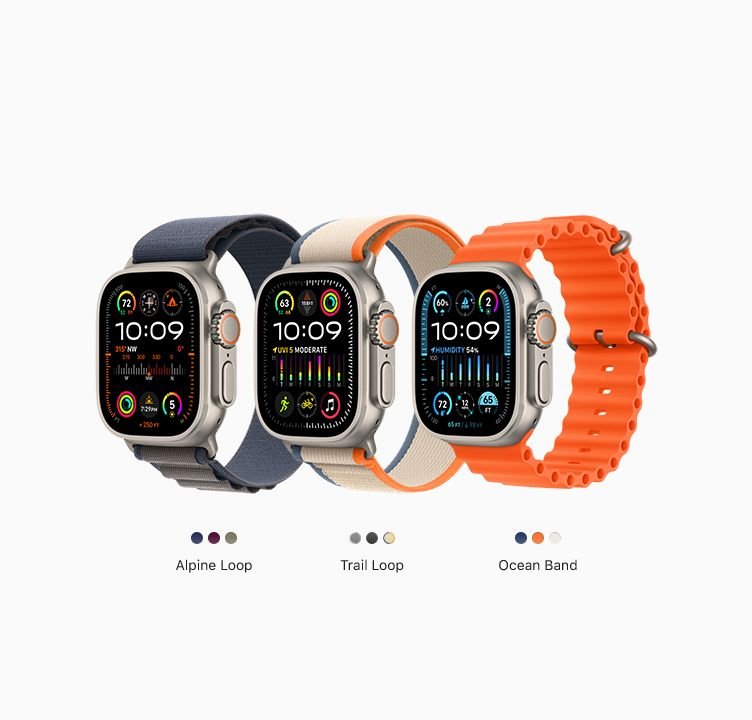Are Apple Watches Really Watches?
When Apple first introduced the Apple Watch in 2015, it was heralded as the next step in wearable technology—a seamless integration of tech and fashion that could revolutionize how we interact with our daily lives. But as the Apple Watch quickly gained popularity, a question began to surface in the world of haute horology: Are Apple Watches really watches? To the casual observer, this may seem like a trivial debate, but for those deeply entrenched in the traditions of fine watchmaking, it strikes at the very heart of what a watch truly is.
Apple Watch Ultra 2 with customizable bands
Historically, watches have been symbols of craftsmanship, precision, and artistry. The world’s most renowned watchmakers, from Patek Philippe to Audemars Piguet, have spent centuries perfecting the art of horology, creating timepieces that are not just tools for telling time, but expressions of human ingenuity and craftsmanship. These watches are meticulously crafted by hand, often taking months or even years to complete, with each component designed to perfection. They are mechanical marvels, relying on gears, springs, and jewels to measure time with extraordinary accuracy. To many, this mechanical complexity is what defines a true watch.
Enter the Apple Watch—a device that, while worn on the wrist and capable of telling time, is powered by a computer chip rather than a series of finely tuned gears and springs. The haute horology community has been vocal in its criticism of Apple Watches, arguing that they lack the soul and craftsmanship that define a true timepiece. To them, an Apple Watch is not a watch in the traditional sense, but rather a wearable gadget, more akin to a smartphone than a piece of horology.
Critics argue that Apple Watches, while impressive in their functionality, are disposable and transient in a way that traditional watches are not. Haute horology is built on the idea of creating something timeless—an object that can be passed down through generations, appreciated for its beauty and craftsmanship across centuries. Apple Watches, on the other hand, are designed to be replaced every few years as new models are released. This rapid obsolescence stands in stark contrast to the enduring nature of mechanical watches, which are built to last a lifetime and beyond.
However, the Apple Watch’s appeal lies in its practical purposes, which go far beyond simply telling time. It’s a fitness tracker, a communication device, a payment method, and a health monitor all rolled into one. For many users, the Apple Watch offers unparalleled convenience, helping them manage their daily lives with ease. It’s a device designed for the modern world, where the ability to track your heart rate or receive text messages on your wrist can be more valuable than the intricate ticking of a mechanical watch.
Customizable Apple Watch Straps
Yet, this very practicality is what further distances the Apple Watch from the realm of true watches. In haute horology, a watch is appreciated not for its utility but for its artistry. The beauty of a finely crafted timepiece lies in its simplicity—its ability to do one thing exceptionally well. A traditional watch is a celebration of time itself, a reminder of the passage of hours and minutes in a world that often moves too fast. The Apple Watch, by contrast, is a tool designed to keep up with that fast-paced world, offering a multitude of functions at the expense of the singular, meditative experience of a mechanical watch.
Furthermore, the design of the Apple Watch, while sleek and modern, lacks the individuality and character that define luxury watches. Haute horology is as much about aesthetics as it is about function, with each watch designed to be a unique work of art. The Apple Watch, with its uniform design and customizable digital faces, is a far cry from the intricate dials and cases that make traditional watches so distinctive. It’s a product of mass production, rather than the meticulous, hand-crafted process that defines true horology.
Ultimately, while the Apple Watch excels as a piece of technology, it falls short of what it means to be a watch in the traditional sense. It may be worn on the wrist and serve as a timekeeping device, but it lacks the mechanical complexity, craftsmanship, and timelessness that define a true watch. It’s a tool for the digital age, a testament to how far technology has come, but not a continuation of the centuries-old tradition of watchmaking.
In conclusion, the Apple Watch is not a watch, at least not in the sense that purists of horology would define one. It’s an innovative, multifunctional gadget that has carved out its own niche in the world of wearable technology, but it does not belong to the same category as the finely crafted timepieces that have been treasured for generations. The Apple Watch is a marvel of modern technology, but it is not, and may never be, a true watch.


